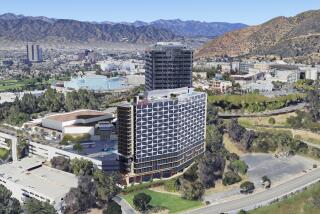L.A. signs off on two downtown hotel towers — and some taxpayer help
The Los Angeles City Council approved a plan Friday for putting a 1,153-room hotel complex across from the Convention Center, providing the developer a lucrative taxpayer subsidy and a deal to adorn the project with digital signs.
The plan, backed unanimously by the council, could provide New York City-based Lightstone Group more than $103 million in public assistance during the project’s first decade, according to an analysis of the deal prepared for the council last year.
City lawmakers also approved a signage plan that is considerably more generous than one recommended earlier this year by Mayor Eric Garcetti’s appointees on the Planning Commission.
The commission voted in March to allow Lightstone to install 12,100 square feet of digital signs at its planned hotel complex, formally known as Fig + Pico. City lawmakers, led by Councilman Jose Huizar, who represents the area, increased that number to 16,750.
Planning commissioners had also recommended that electronic signs be prohibited on the Flower Street side of the project, to ensure that nearby residents would not have to contend with the visual impact. The council removed that restriction, allowing up to 1,650 square feet of digital signs on Flower.
Lightstone and its representatives declined to say why the project would benefit from the larger amount of digital signs. Instead, Lightstone President Mitchell Hochberg issued a statement saying he looks forward to being “part of the vibrant fabric” that makes up downtown.
The vote to approve Fig + Pico comes a week after Anschutz Entertainment Group announced its own plan for building an 850-room hotel next to the Convention Center. AEG plans to seek taxpayer assistance for its project as well.
Fig + Pico will offer three hotels inside two towers — one 38 stories, the other 27 — on Pico Boulevard between Figueroa and Flower Streets. The project would replace parking lots and a Hooters restaurant, among other things.
As part of Friday’s series of votes, the council agreed to sell Lightstone a city-owned parking lot at Figueroa and Pico for $9.6 milion.
Backers say Fig + Pico is a critical part of the city’s strategy for ensuring that 8,000 hotel rooms are within walking distance of the Convention Center. Those rooms are needed as L.A. competes against Anaheim, San Diego and other cities for convention and tourism business, supporters say.
“This project will provide visitors with strategically located, attractive and affordable lodging options, while also materially improving our ability to compete for conventions,” said Doane Liu, executive director of the city’s Department of Convention and Tourism Development, earlier this week.
Fig + Pico is one of several downtown hotel developments, including the recently completed Wilshire Grand, to receive public assistance. Critics say the tourism industry is healthy enough in L.A. that taxpayers shouldn’t have to pitch in.
“The city keeps giving these huge subsidies to these megadevelopers and, meanwhile, they are not building enough affordable housing. Those kinds of things are what the city needs,” said Ileana Wachtel, spokeswoman for the Coalition to Preserve L.A., a nonprofit group that weighs in on development, housing and other issues.
Huizar declined to grant an interview on the project, issuing a statement from his spokesman saying the package of financial incentives had been recommended by the city’s chief legislative analyst, a high-level policy advisor to the council.
Huizar said in the statement that he favored the larger amount of digital signs because it was the amount studied in the project’s environmental impact report — and had originally been recommended by planning department staff.
City officials contend the subsidy is needed because Lightstone’s project faces a financial gap, in part due to higher construction costs. Even with the subsidy, the project will generate an additional $384.8 million in tax revenues for the city over 25 years, according to the analysis prepared for the council.
Backers say the project will provide other benefits for the city, including a promise to have rooms available for the 2028 Olympics, which will be staged in Los Angeles.
Fig + Pico has drawn support from downtown business groups and from unions that represent hotel and construction workers. They contend the project will create better-paying jobs and a boost to the city’s hospitality industry.
Twitter: @DavidZahniser
More to Read
Sign up for Essential California
The most important California stories and recommendations in your inbox every morning.
You may occasionally receive promotional content from the Los Angeles Times.











